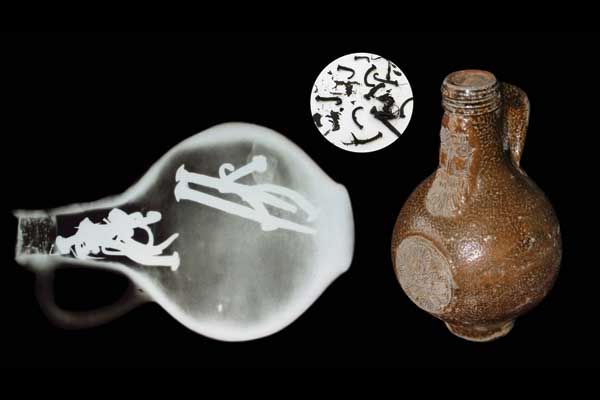The witch bottle is a very old spell device. Its purpose is to draw in and trap harmful intentions directed at its owner. Folk magic contends that the witch bottle protects against evil spirits and magical attack, and counteracts spells cast by witches.
A traditional witch bottle is a small flask, about 3 inches high, created from blue or green glass. Larger and rounder witch bottles, up to 9 inches high, were known as Greybeards and employed so-called Bartmann or Bellarmine jugs. Bellarmines were named after a particularly fearsome Catholic Inquisitor, Robert Bellarmine, who persecuted Protestants and was instrumental in the burning of Giordano Bruno . Greybeards and Bellarmines were not made of glass, but of brown or gray stoneware that was glazed with salt and embossed with severe bearded faces designed to scare off evil.
A witch, cunning man or woman, would prepare the witch's bottle. Historically, the witch's bottle contained the victim's (the person who believed they had a spell put on them, for example) urine, hair or nail clippings, or red thread from sprite traps. In recent years, the witch's bottle has taken on a nicer tone, filled with rosemary, needles and pins, and red wine. Historically and currently, the bottle is then buried at the farthest corner of the property, beneath the house hearth, or placed in an inconspicuous spot in the house. It is believed that after being buried, the bottle captures evil which is impaled on the pins and needles, drowned by the wine, and sent away by the rosemary.
Sometimes seawater or earth are used instead. Other types of Witch-bottles may contain sand, stones, knotted threads, feathers, shells, herbs, flowers, salt, vinegar, oil, coins, or ashes. A similar magical deceive is the "lemon and pins" charm.
Another variation is within the disposal of the bottle. Some witch's bottles were thrown into a fire and when they exploded, the spell was broken or the witch supposedly killed.
This form of "bottled spell" dates back hundreds of years, and were prevalent in Elizabethan England - especially Anglia, where superstitions and belief in witches were strong. The bottles were most often found buried under the fireplace, under the floor, and plastered inside walls.
The Witch-bottle was believed to be active as long as the bottle remained hidden and unbroken. People did go through a lot of trouble in hiding their Witch-bottles - those buried underneath fireplaces have been found only after the rest of the building has been torn down or otherwise disappeared. The origins of this tradition have been dated at least to the 16th century. In ancient times the bottles were made of stone and originally contained rusty nails, urine, thorns, hair, menstrual blood, and pieces of glass, wood, and bone.
Unsolved mysteries of witch bottle


No comments:
Post a Comment